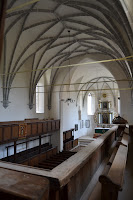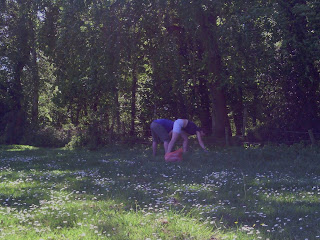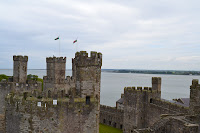This summer we had a week-long wander around Transylvania, first to the forts and fortified churches in the centre of the region, and then making our way west to the Dacian ruins.
The weather was fantastic as we started out in Prahova valley,
making our way north to Rasnov Citadel. We had a walk inside the citadel walls and ate icecream, and then moved on to Rupea Castle.
This was unfortunately closed for repairs, which was a real shame. It is a
very old castle, first built as a Dacian fortress, then a Roman fort,
then a medieval castle, which is all reflected in the walls added from
one period to the next.
Just before closing time, as the keeper was heading home, we made it to Saschiz, one of the UNESCO World Heritage fortified churches. I think we tested the keeper's patience a bit by exploring every single corner including the attic.
And then we finally made it to the campsite. A wonderful campsite, small, quiet, cozy, and very international, kept by a lovely Dutch couple, probably the best campsite I ever stayed in. They even organised a meal for us with neighbours who have a small farm, and who were nice enough to walk us through their garden, orchard, and show us some of the animals. Including this very cute Romanian Shepherd puppy.
The next day we spent some time at Biertan, another fortified church.
And then made our way to Sighisoara, a city with a very well-preserved medieval city centre.
Next day's travels took us westwards to Medias (an old town centre not as well maintained as most other towns we saw, but getting there), Blaj (which used to be an important patriotic and religious centre), and finally Alba-Iulia.
The fort in Alba-Iulia is very impressive. It is absolutely massive and contains a 13th century Catholic Cathedral as well as the Transylvanian centre of the Romanian Orthodox Church, Roman fortification ruins, a lot of old romantic buildings, and a few very pleasant cafes and restaurants.
And that evening we were finally at our final destination - the village of Costesti in Alba county, the closest village to the UNESCO World Heritage Dacian fortresses. The Dacians were a civilisation concentrated in western Romania, although at the peak of their expansion in the 1st century BC they would have spread as far as today's Bulgaria, Serbia, Hungary, and Ukraine. They were conquered by the Romans and Dacia became a province in 106AD. Wikipedia can tell you a lot more about the Dacians if you like.
Near Costesti, accessible on a 20 km dirt road, you can reach the former Dacian capital of Sarmisegetuza Regia. It still displays some of the main citadel features, such as the surrounding walls and paved entrance.
There is also the spiritual terrace, which was the Dacian religious centre, displaying a number of small and large, circular and square sanctuaries, as well as an altar, a formation they think was a sort of sun calendar, and the original water supply stream (great water!). All that is preserved from the sanctuaries are the foundation stones. The Dacians used wooden structures, so it is unclear what shape these temples had, whether they had several rooms, roofs, or if they were connected.
We also visited Blidaru, a fort accessible from Costesti via a footpath through the woods. The walk was beautiful and we got a great vibe from the place. It was a very strong fort and was never really conquered by the Romans, but rather ran out of drinking water during a siege.
And finally, Costesti fort. The original name is unknown, so it is named after the nearby village. Another interesting fort which was at times the residence of the Dacian king, where you can see part of the dwelling towers, and some more temples.
If by chance you get to Bucharest after seeing the Dacian forts, go
to the National History Museum to see the reproduction of Trajan's column which documents the whole of the Dacian wars. It makes the whole
experience of seeing the ruins come alive.
Beside going there for the Dacian forts, the region is of outstanding beauty, and less crowded than other mountainous regions in Romania, and there are several walking routes. We stayed at a very nice B&B in Costesti, where you can also hire mountain bikes to cycle to the forts. And we had some fantastic companions to cheer us up along the way.
Wine labelling
The first batches of homemade wine we made were stored in bottles with hand-written stickers on them, creatively entitled 'Blackberry 2010' or similar. However, having been inspired by friends' fantastic labels, we decided to get our creative juices flowing (yes, bad pun intended).
We bottled three types of wine a few months ago. So we went out and got ourselves a printer and some labels. And on a rainy Sunday morning, we repeatedly sampled the wines to receive the inspiration for their names and description. Here's the result.
Saint Bernard's, named in celebration of our former address where this wine was so lovingly started. Do read the back! (in the interest of bragging, I need to mention all drawings are made by us)
Raisin' El, a raisin and elderberry wine. The play upon words is a bit subtle, I know, but do notice the horns on the raisin!
And last but not least, Re-Wine, named because the fruit from the Saint Bernard's wine was re-used to make this wine.
Brilliant, if I do say so myself!
Oh, and at the same time we also bottled a couple of liqueurs (fruit + gin + sugar).
We bottled three types of wine a few months ago. So we went out and got ourselves a printer and some labels. And on a rainy Sunday morning, we repeatedly sampled the wines to receive the inspiration for their names and description. Here's the result.
Saint Bernard's, named in celebration of our former address where this wine was so lovingly started. Do read the back! (in the interest of bragging, I need to mention all drawings are made by us)
Raisin' El, a raisin and elderberry wine. The play upon words is a bit subtle, I know, but do notice the horns on the raisin!
And last but not least, Re-Wine, named because the fruit from the Saint Bernard's wine was re-used to make this wine.
Brilliant, if I do say so myself!
Oh, and at the same time we also bottled a couple of liqueurs (fruit + gin + sugar).
Wine making
Even though we have made wine for the last two years, we were foolish enough not to keep the recipes. So we can't share the secrets to the delicious wines so far, but we're doing better at record-keeping and we'll post recipes as the current wines mature...
Until then, we thought it would be nice to write a step-by-step intro to our wine making.
Step 1. This involves being out and about finding the ingredients. So far, we have only made wine and other brews out of foraged (free) ingredients. These include blackberries, sloeberries, elderberries, rosehips, nettles, quince, and elderflower. Here's us collecting nettles recently (thank you, Ann-Marie for the dignified photo!)
Step 2. Next, we select and wash the fruit. Then mix them up with hot water, sugar, and yeast and leave them in a bucket for a few days to start the fermentation process. Below are the fruit for one of the blackberry and elderberry wines from 2010.
Until then, we thought it would be nice to write a step-by-step intro to our wine making.
Step 1. This involves being out and about finding the ingredients. So far, we have only made wine and other brews out of foraged (free) ingredients. These include blackberries, sloeberries, elderberries, rosehips, nettles, quince, and elderflower. Here's us collecting nettles recently (thank you, Ann-Marie for the dignified photo!)
Step 2. Next, we select and wash the fruit. Then mix them up with hot water, sugar, and yeast and leave them in a bucket for a few days to start the fermentation process. Below are the fruit for one of the blackberry and elderberry wines from 2010.
Step 3. After that, the juice strained from the bucket goes into demijohns (large 10 litre glass containers).
Step 4. It stays in demijohns until in stops fermenting (and it may be transferred between demijohns a few times to get rid of the sediments), at which point it is transfered into bottles.
Step 5. Bottles get labelled.
Step 6. Wait 2 years... and drink it!
North Wales
A business trip to the lovely north of England presented us with the opportunity to stop for a few days in North Wales on the way back. Yet another one of our camping, hiking, and castle-ing escapades (we really should go on a lay-on-the-beach-all-day holiday sometime...).
As we ventured into Snowdonia National Park and road signs went from English to bilingual to ulimately Welsh-only, we made our way to a campsite recommended by the guidebook for easy access to hiking routes. Basically, a farmer's field in a barren, windy, and cold river valley, with nothing else around. The farmer was lovely though! But somehow that didn't help regreting the choice of campsite when 7pm would always find us lying inside the tent with most of our clothes on, in sleeping bags, watching the ceiling. Here's the valley.
Not sure what happened there (thanks, guidebook!), but it took us 5 hours and it was one of the most difficult hikes, especially the descent, very steep and entirely on scree (see from above and below). I wondered at the time why there were no tourists on these peaks, the only people we encoutered were elite Royal Marines training their socks off on this route.
For the next day we had planned hiking up Snowdon (highest peak in Wales), but after this lovely adventure we decided we needed a day of castle-ing to break up the mountaneering. The first one we saw was Conwy Castle, cool in itself and set in the nicest little town, with lots more attractions beside the castle.
On the way to Conwy we stopped in Llandudno, a very touristy resort by the seaside, but with lots of nice cafes and a gorgeous beach. Here, we stopped at the Great Orme Mines - and this was FANTASTIC!! Ancient copper mines dating 2 milenia B.C., of an unbelievable scale seeing that they only had bits of bones or shells to dig with. The complexity of galleries makes a joke out of most 19th century mines.
We had postponed it, but now we were going to do it. It was going the day for the hike up Snowdon. Several factors, among which having slept in the freezing cold farmer's field, the full carpark by the Snowdon ascent path, and general grumpiness amongst our ranks saw it postponed to the next day. Thus began another day of castle-ing. The Caenarfon castle, where we also stopped for Roman fort ruins.
And after that we drove across to Anglesey, and saw Beaumaris - town and castle. The town is very nice if not a bit pretentious. The caslte was never finished so it is not as tall as Conwy or Caenarfon, but it was much emptier so we had a chance to explore all the corridors, towers, and galleries without bumping into tourists (pesky tourists!) all the time. The other cool thing about the castle is that it's surrounded by water - proper fairy-tale medieval setup.
What do you think happened the next day?... Well, this time we finally got our act together and hiked up Snowdon. It didn't rain on us, but unfortunatelly it wasn't clear either.. Well, we got a bit of a view and had an opportunity to be silly at 1085 meters.
Both lakes below Snowdon are linked to numerous myths, some of monsters lured there to destruction by vengeful maidens, some about King Arthur and Merlin, some about Llyn Glaslyn being the lake where Excalibur is to be found.
By this time, we had given up on the cold farmer's field and moved to grassier, sunnier lands in a campsite in Beddgelert, the nicest village with a couple of pubs with delicious food. But then again after days of packed noodles, packed rice, and packed lukewarm soup cooked on our little hiking cooker, any properly cooked food would have been blissful.
On the last day we went for a walk in the Aberglaslyn gorge. A very beautiful walk through the gorge, and up the hills covered in Welsh mining history.



At the end of the walk we finished by Llyn Dinas, a beautiful lake by the legendary Dinas Emrys fort, a place of old British and Arthurian legens.
As we ventured into Snowdonia National Park and road signs went from English to bilingual to ulimately Welsh-only, we made our way to a campsite recommended by the guidebook for easy access to hiking routes. Basically, a farmer's field in a barren, windy, and cold river valley, with nothing else around. The farmer was lovely though! But somehow that didn't help regreting the choice of campsite when 7pm would always find us lying inside the tent with most of our clothes on, in sleeping bags, watching the ceiling. Here's the valley.
To avoid our usual pitfall - doing too much on the first day - we chose a nice guidebook-recommended 2-hour track the next day. The walk took us from the campsite to the two Carneddau peaks, Carnedd Dafydd and Carnedd Llewelyn. They are named after the last Weslh king, Llewelyn, and his brother Dafydd. Here are the two peaks below.
Not sure what happened there (thanks, guidebook!), but it took us 5 hours and it was one of the most difficult hikes, especially the descent, very steep and entirely on scree (see from above and below). I wondered at the time why there were no tourists on these peaks, the only people we encoutered were elite Royal Marines training their socks off on this route.
On the way to Conwy we stopped in Llandudno, a very touristy resort by the seaside, but with lots of nice cafes and a gorgeous beach. Here, we stopped at the Great Orme Mines - and this was FANTASTIC!! Ancient copper mines dating 2 milenia B.C., of an unbelievable scale seeing that they only had bits of bones or shells to dig with. The complexity of galleries makes a joke out of most 19th century mines.
We had postponed it, but now we were going to do it. It was going the day for the hike up Snowdon. Several factors, among which having slept in the freezing cold farmer's field, the full carpark by the Snowdon ascent path, and general grumpiness amongst our ranks saw it postponed to the next day. Thus began another day of castle-ing. The Caenarfon castle, where we also stopped for Roman fort ruins.
And after that we drove across to Anglesey, and saw Beaumaris - town and castle. The town is very nice if not a bit pretentious. The caslte was never finished so it is not as tall as Conwy or Caenarfon, but it was much emptier so we had a chance to explore all the corridors, towers, and galleries without bumping into tourists (pesky tourists!) all the time. The other cool thing about the castle is that it's surrounded by water - proper fairy-tale medieval setup.
What do you think happened the next day?... Well, this time we finally got our act together and hiked up Snowdon. It didn't rain on us, but unfortunatelly it wasn't clear either.. Well, we got a bit of a view and had an opportunity to be silly at 1085 meters.
Both lakes below Snowdon are linked to numerous myths, some of monsters lured there to destruction by vengeful maidens, some about King Arthur and Merlin, some about Llyn Glaslyn being the lake where Excalibur is to be found.
By this time, we had given up on the cold farmer's field and moved to grassier, sunnier lands in a campsite in Beddgelert, the nicest village with a couple of pubs with delicious food. But then again after days of packed noodles, packed rice, and packed lukewarm soup cooked on our little hiking cooker, any properly cooked food would have been blissful.
On the last day we went for a walk in the Aberglaslyn gorge. A very beautiful walk through the gorge, and up the hills covered in Welsh mining history.



At the end of the walk we finished by Llyn Dinas, a beautiful lake by the legendary Dinas Emrys fort, a place of old British and Arthurian legens.
Subscribe to:
Posts (Atom)










































































